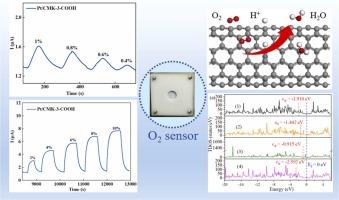High-sensitive electrochemical oxygen gas sensor with zero power consumption based on Pt/CMK-3-COOH modified ionic liquid as composite electrolyte
IF 3.7
1区 化学
Q1 CHEMISTRY, ANALYTICAL
引用次数: 0
Abstract
The modification of ionic liquid electrolytes is of particular importance for the development of high-performance electrochemical oxygen sensors with zero power consumption but still quite challenging. Herein, we designed and synthesized an electrochemical oxygen sensor based on the modified Pt/CMK-3-COOH-[EMIM][OAc] ionic liquid as composite electrolyte, where the -COOH functional group was introduced by acidifying CMK to provide hydrogen protons, and then Pt nanoparticles with different contents were loaded to improve the activity of the sensor towards O2 gas as well as the conductivity of ionic liquid. Such composite ionic liquid sensor exhibits excellent O2 detection ability with high sensitivity (0.58 μA/[%O2]), high stability, wide detection range (0.4-10%), and zero-power consumption, along with the detection limit as low as 0.4%. Furthermore, it has humidity-independent gas-sensing characteristic. Moreover, density functional theory (DFT) calculations combined with experimental results were applied to deeply unveil the improved O2 sensing mechanism. Compared with CMK, the introduction of Pt/CMK-3-COOH material increases the conductivity of the ionic liquid, decreases the adsorption energy of the sensor for O2 and hydrogen protons, promotes the oxygen reduction reaction, and simulates the transfer of effective charge, thereby significantly improving O2 sensing. This work provides a high-performance ionic liquid oxygen sensor, showing potential application in zero-power consumption and low concentration O2 detection.

以Pt/CMK-3-COOH改性离子液体为复合电解质的零功耗高灵敏度电化学氧气传感器
离子液体电解质的改性对于开发高性能的零功耗电化学氧传感器具有重要意义,但仍具有很大的挑战性。本文以改性的Pt/CMK-3- cooh -[EMIM][OAc]离子液体为复合电解质,通过酸化CMK引入- cooh官能团提供氢质子,然后加载不同含量的Pt纳米颗粒,提高传感器对O2气体的活性,提高离子液体的导电性。该复合离子液体传感器具有灵敏度高(0.58 μA/[%O2])、稳定性好、检测范围宽(0.4 ~ 10%)、零功耗、检出限低至0.4%等优点。此外,它具有不依赖湿度的气敏特性。利用密度泛函理论(DFT)计算并结合实验结果,深入揭示了改进后的O2传感机理。与CMK相比,Pt/CMK-3- cooh材料的引入提高了离子液体的电导率,降低了传感器对O2和氢质子的吸附能,促进了氧还原反应,模拟了有效电荷的转移,从而显著提高了O2的传感能力。该工作提供了一种高性能离子液氧传感器,在零功耗和低浓度O2检测中具有潜在的应用前景。
本文章由计算机程序翻译,如有差异,请以英文原文为准。
求助全文
约1分钟内获得全文
求助全文
来源期刊

Sensors and Actuators B: Chemical
工程技术-电化学
CiteScore
14.60
自引率
11.90%
发文量
1776
审稿时长
3.2 months
期刊介绍:
Sensors & Actuators, B: Chemical is an international journal focused on the research and development of chemical transducers. It covers chemical sensors and biosensors, chemical actuators, and analytical microsystems. The journal is interdisciplinary, aiming to publish original works showcasing substantial advancements beyond the current state of the art in these fields, with practical applicability to solving meaningful analytical problems. Review articles are accepted by invitation from an Editor of the journal.
 求助内容:
求助内容: 应助结果提醒方式:
应助结果提醒方式:


